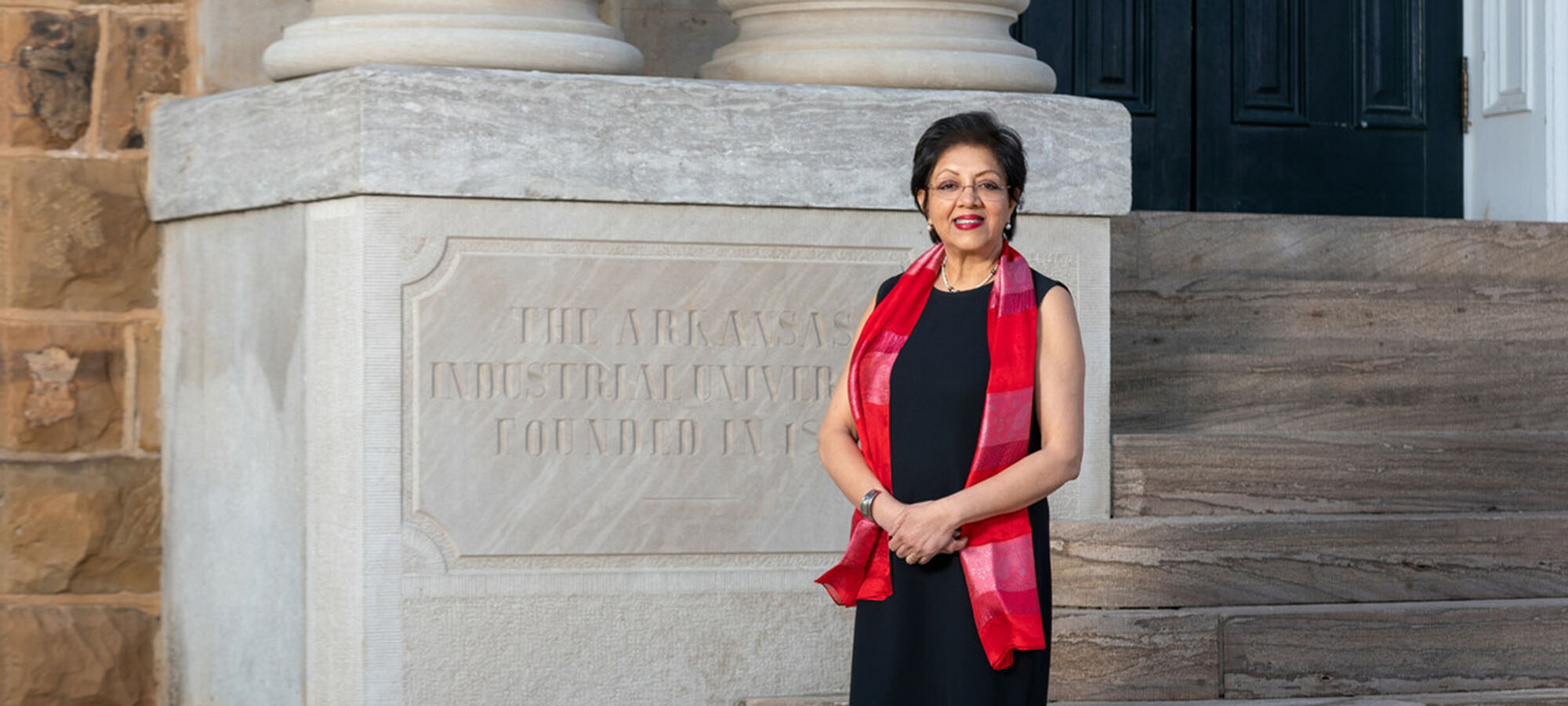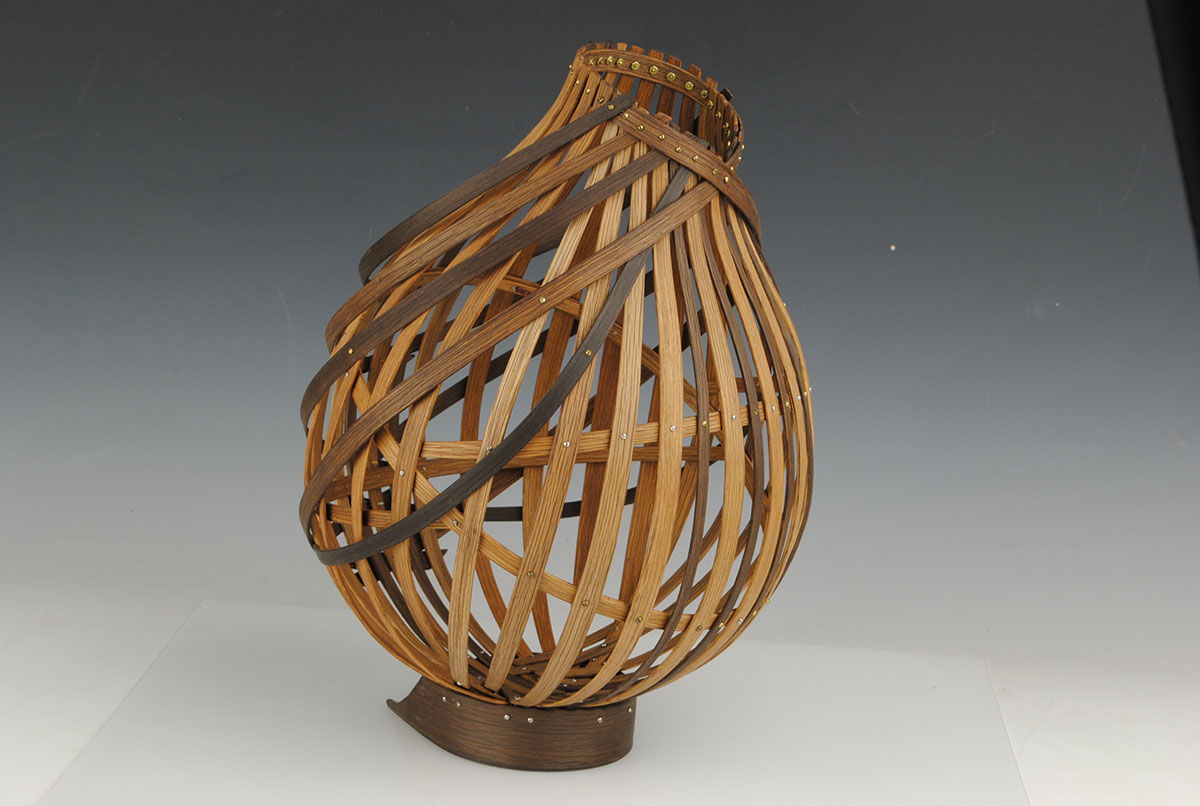
Challenge Accepted:
Ranu Jung Takes Helm of New I3R
Ranu Jung is a researcher and visionary who cherishes a challenge. She’s also a builder. She builds systems for artificial limbs that communicate with a person’s nervous system, and she builds teams, programs and futures.
At the University of Arkansas, she is building I3R –the new Institute for Integrative and Innovative Research.
 The Institute for Integrative and Innovative Research is the result of a $194.7 million
grant from the Walton Family Charitable Support Foundation. Given in 2020, it was
one of the largest single private gifts ever given to a university for advancing research
and economic development. The grant is being used for the construction of the university’s
new research facility, which will house I3R and endow the Institute.
The Institute for Integrative and Innovative Research is the result of a $194.7 million
grant from the Walton Family Charitable Support Foundation. Given in 2020, it was
one of the largest single private gifts ever given to a university for advancing research
and economic development. The grant is being used for the construction of the university’s
new research facility, which will house I3R and endow the Institute.
Jung joined the U of A in December 2021 as the founding executive director of I3R, and she is determined to make the university a global leader in discovery and applied innovation. The institute, which is funded by a grant from the Walton Family Charitable Support Foundation, seeks to support convergence of ideas and actions in pursuit of solutions for complex challenges we face today – and likely in the future. In short, it’s a game changer and will ensure Arkansas stays at the forefront of discovery and innovation while making a societal impact.
“I3R has the potential to shape solutions to impact an entire community, the nation and even the world,” Jung said. “We have a foundational gift that will allow us to pull together teams to address challenges and create a lasting change.”
As the inaugural executive director, Jung will build the foundation for the future of I3R by shaping the vision and mission, creating collaborative spaces and fostering industry and community partnerships. The initial grand challenge that I3R plans to address is Metabolic Health, including promoting, sustaining and restoring good health and well-being. This focus will be supported by Health+Technology and Food+Technology, two eco-systems that support “Nodes of Research Excellence” identified to create, receive and connect vital information central to the challenge.
“If we do this correctly, we have the opportunity to transform things,” Jung said. “You don’t get opportunities like these often, so we have a responsibility to make important things happen. This new institute will be driven by purpose. We will take transformative discoveries, develop and translate them, deliver and deploy them at scale for societal impact. As a university, we have to think about how we can impart this kind of change.”

The merging of research and administration has always been appealing to Jung, because it gives her the ability to change the future through teamwork and shape the next generation.
“We always need another generation to carry our work forward,” she said. “That’s the beauty of working in academics. We are future-looking and have a pioneering spirit.”
One of the initial action items of I3R involves growing the research team to include members from a diverse range of disciplines necessary to address the challenge of Metabolic Health. The Institute will also involve students in the research, discovery and translation process, engaging them not only in faculty-identified research but also in a broad spectrum of industry, clinical, and community organization-identified projects. These will span the areas of science, engineering, all things digital, public health, economics, ethics, law and policy, journalism, art and architecture, among others.
The Beauty of Discovery
Perhaps it shouldn’t be a surprise how much Jung relishes the prospect of embracing new opportunities. Growing up in Bhilai, India, as the daughter of an engineer and English teacher, Jung was surrounded by a community with pioneering spirits and can-do attitudes on a mission to build a nation. “I learned that you can dream and do whatever you want in the world,” she said.
“I learned that you can dream and do whatever you want in the world,” she said.
While pursuing a bachelor’s degree in electronics and communication engineering from the National Institute of Technology in Warangal, India, Jung became involved in a problem-oriented research lab, that offered her an opportunity to conduct research and experience the thrill of discovery.

“When I came to Case Western Reserve University [for graduate school in biomedical engineering], I gained a better understanding of how the brain controls our cardiovascular and respiratory systems and was introduced to neuroscience and medicine,” she said. “As a child, I was always a curious kid who was asking ‘why.’ The program was a good fit for me. I knew I needed a place where I could strengthen my engineering roots and still be me.”
It was also here that she met Peter Katona, Chair of the Department of Biomedical Engineering, who served as graduate degree advisor and mentor to her. When Jung asked him how she would know if she had successfully completed her doctoral research, he left her with some words of wisdom that she has carried with her since.
“He told me I would be done when I created something beautiful,” she said. “From him, I learned the beauty of discovery and creating something – the process of bringing things together to envision a beautiful solution.”
A New Generation of Innovation
Jung continued her academic career at the University of Kentucky, Arizona State University and Florida International University before joining the University of Arkansas in December 2021. Along the way, she received more than $27 million in research grants awarded as a principal or co-principal investigator, was included in more than 100 refereed publications and was granted 14 U.S. patents. With every step, she honed her ability to bring a vision to life and turn discoveries into applicable inventions.
“When you join in on a common mission, there’s always a path forward,” she said.
Jung’s work with prosthetics through the Adaptive Neural Systems Laboratory is perhaps the best example of her enterprising spirit and ability to assemble a team.
In the ANS lab, Jung and her colleagues designed and developed technology to offset the effects of limb amputation.
Her underlying philosophy is that technologies must be centered on the user, and researchers and clinicians must understand the needs of the person; otherwise, new technologies won’t improve their lives.
Over the last several years, Jung and her fellow collaborators have worked to restore sensation to individuals using prosthetics and received funding from the National Institute of Health, Defense Advanced Research Projects Agency and the US Army to pursue their research. She and her team created the first wireless, implantable, neural-interface system for restoring sensations to amputees and received FDA approval to conduct first-in-human trials. Their work has opened up an entirely new world for individuals by giving them the opportunity to feel again.
 Among her many honors, Jung was named a Fellow of the National Academy of Inventors
in 2017, the American Institute for Medical and Biological Engineering in 2013 and
the Biomedical Engineering Society in 2020. In 2022, she was named a Fellow of the
American Association for the Advancement of Science, the world’s largest general scientific
society and publisher of the journal Science.
Among her many honors, Jung was named a Fellow of the National Academy of Inventors
in 2017, the American Institute for Medical and Biological Engineering in 2013 and
the Biomedical Engineering Society in 2020. In 2022, she was named a Fellow of the
American Association for the Advancement of Science, the world’s largest general scientific
society and publisher of the journal Science.
This targeted neurostimulation of the nerves will have more widespread applicability than just prosthetics. Jung notes that the technology can be used throughout the body, even for internal organs, and the team is researching whether the work can be applied to allow sensorial experiences when interacting with virtual objects as well.

Clinical trials will continue at the University of Arkansas under the direction of James Abbas, who has worked with Jung for many years. Thanks to funding from the National Institute of Health, and the Army, the study will be expanded to new participants, and students will have the opportunity to participate in this life-changing work.
“I’ve had students who have worked with me as undergraduates go on to become my colleagues,” Jung said. “The next generation will carry on our work, and they will be given unique opportunities as part of our team. It will be amazing to see what we can achieve because we are so integrated.”